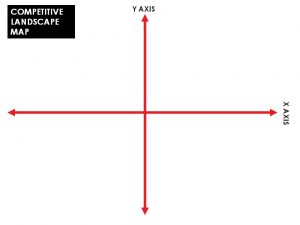How to Plot Your Brand Positioning — “Scale-Up Your Brand” Series
My blog series on “How to Scale-Up Your Brand” continues today with instructions on how to plot your brand positioning. A clear competitive brand positioning is essential to brand-building because it defines who you are selling to, what your business scope is, and how you create unique value for your customers. In this post, you’ll learn how to identify the optimal position for your brand.
What Is Brand Positioning?
Your brand positioning is one part of the strategic platform of your brand. It describes how you compare and compete with other brands. The other part of your strategic brand platform is your brand identity, which articulates what you stand for and believe in. In a previous post in this series, I introduced some brand tools to help you identify and clarify the key elements of your brand identity. And you can learn more about the integration of brand identity and brand positioning in this post on strategic brand platforms..
A brand positioning statement uses this framework:
For [core customer], we are the [competitive frame of reference] who does [unique value], because [reasons to believe].
This post explains this brand positioning framework and I outline a brand tool, customer collage, for identifying your core customer here.
Today I address how to define your competitive frame of reference, or category of choice, and how to identify your unique value, or unique customer benefit.
- Your competitive frame of reference is the mental file folder you want your customers to put you in. Usually this is your industry category, but keep in mind that people don’t necessarily think of products in terms of specific categories and in some cases you might be creating a new category so there is no obvious frame of reference. Plus, many purchase decisions involve “indirect competition” in which consumers ask themselves: Juice or soda? Dinner or movie? Vacation or new car? So your competitive frame of reference requires careful consideration.
- The unique value of your brand is what you do for people that either no one in your competitive frame of reference does as well as you, or no one does at all. You should think about and articulate this in terms of a customer benefit, what’s in it for them. Look at what you do from your customers’ — not your own — point of view. Your unique value will differ depending on your competitive frame of reference so here’s how you develop these two elements simultaneously.
Five Steps to Plot Your Brand Positioning
Follow these steps to define your competitive frame of reference and identify your unique value:
1. Start by thinking differently about what business you’re really in. Consider what you do for people instead of the product/service you produce. You may be a mobile carrier, but are you really in the productivity business? You might be selling running shoes, but are you really in the inspiration business? You might be an insurance provider, but are you really in the freedom business? Create a list of the possible businesses you might be in and identify the leading brands in each. The one that most directly reflects how your core customers think about what you do is probably your most effective competitive frame of reference.
2. Consider what lifestage your brand or product is in. If you are just starting out, you should define your competitive frame of reference more narrowly since your primary challenge is simply getting people to choose you over other existing options. Later in the lifestage of your product or brand, you should define your frame more broadly since you’ll probably want to consider avenues for new growth through adjacent markets, categories, capabilities.
Your answers to #1 and #2 should lead you to an understanding of the best definition and scope for your competitive frame of reference.
3. The next step is to list key competitors in your competitive frame of reference and the unique benefit each delivers. Use industry research, analyst reports, audits of competitors’ experiences and communications, and social media listening to help you understand each brand’s points of strength and differentiation. Synthesize your findings into a succinct description of each competitor’s unique benefit.
4. Use competitive landscape maps to identify the competitive white space for your brand. Begin by drawing several charts, each with an x and y axis. For the first chart, start with axes that are standard for your category — for a snack food, for example, your axes might be low price vs. premium, sweet vs. salty, or for kids vs. for adults. Plot on the chart the relative positions of brands in your competitive frame of reference.
Move onto the next chart, using different axes and placing the competitors on each. Consider axes that represent different attributes for your category (for snack foods, you might think about single serve vs. multiple servings or indulgent vs. healthy). Continue to create new charts, experimenting with different axes, especially those that speak to customer emotions (energizing vs. relaxing) or different usage occasions (meal replacement vs. treat). Also use axes that reflect the drivers in your answers to #1 above.
5. Finally identify the unique value of your brand by evaluating the opportunities in the landscapes. In each chart, pinpoint where the competitive white space is and place your brand in that white space. Then for each chart examine the positions and unique benefits of competitive brands and identify the unique value of your brand relative to theirs in the context of that white space. Once you’ve examined several charts, the one that reveals the most compelling value for your brand should become clear. It’s the one with the most significant white space and the most differentiating benefit.
This process involves both art and science — and it takes some practice to do it well. Try it out with your brand and then let me know if you’d like help or feedback. Leave your comments below or contact me here.
Up Next: Brand Differentiators
My next post in this “How to Scale-Up Your Brand” series covers the last element of your brand positioning, the reasons to believe, your key brand differentiators. I will show you how to identify and prioritize the ones that give your brand the most power and competitive advantage. Look for it here in a couple of weeks.
previous posts in the “How to Scale-Up Your Brand” series:

